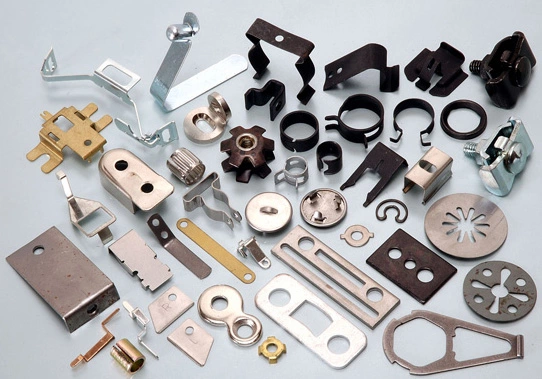Introduction and Application of Stamping Parts
Posted: Jun 19, 2015 Hits: 1534
The production of stamping parts is a shaping process of plates, strips, pipes and profiles imposed by external forces from press machines and moulds to give rise to plastic deformation or separation so as to achieve stamping parts with required shape and dimension. As with forging, stamping is also plastic processing or pressure processing. Blanks for stamping are mainly hot-rolled and cold-rolled steel plates and steel strips.
Stamping parts are thinner, lighter and more homogeneous than castings and forgings. Stamping method can be used to produce parts with reinforcing ribs, different shapes or flanging forms which are not easily achieved by other methods. Due to adoption of precision moulds, the precision of stamping parts can be micron-sized and identically dimensional.
Cold stamped parts do not require cutting work or just need little cutting work. Hot stamped parts have precision and surface states inferior to cold stamped pars, but still have advantages like little cutting work over castings and forgings.
Stamping is an efficient method. With compound die, especially multi-position progressive die, many stamping procedures can be conducted just by one press machine, achieving full-automatic production. Due to high efficiency and favorable working conditions, hundreds of stamping parts can be produced in one minute.
60%~70% of steels in the world are plates which are mostly fashioned into finished products by stamping method, such as automobile body, chassis, fuel tank, radiator fin, boiler steam drum, shell parts of containers, etc. Besides, stamping parts are also widely applied in instruments and meters, household appliances, bicycles, office equipment, etc.
Stamping parts are thinner, lighter and more homogeneous than castings and forgings. Stamping method can be used to produce parts with reinforcing ribs, different shapes or flanging forms which are not easily achieved by other methods. Due to adoption of precision moulds, the precision of stamping parts can be micron-sized and identically dimensional.
Cold stamped parts do not require cutting work or just need little cutting work. Hot stamped parts have precision and surface states inferior to cold stamped pars, but still have advantages like little cutting work over castings and forgings.
Stamping is an efficient method. With compound die, especially multi-position progressive die, many stamping procedures can be conducted just by one press machine, achieving full-automatic production. Due to high efficiency and favorable working conditions, hundreds of stamping parts can be produced in one minute.
60%~70% of steels in the world are plates which are mostly fashioned into finished products by stamping method, such as automobile body, chassis, fuel tank, radiator fin, boiler steam drum, shell parts of containers, etc. Besides, stamping parts are also widely applied in instruments and meters, household appliances, bicycles, office equipment, etc.

